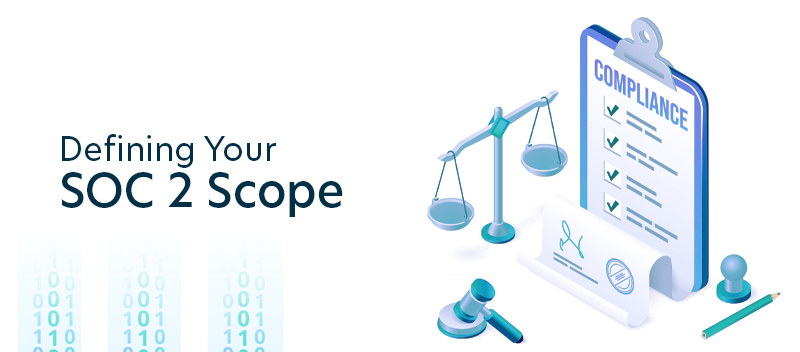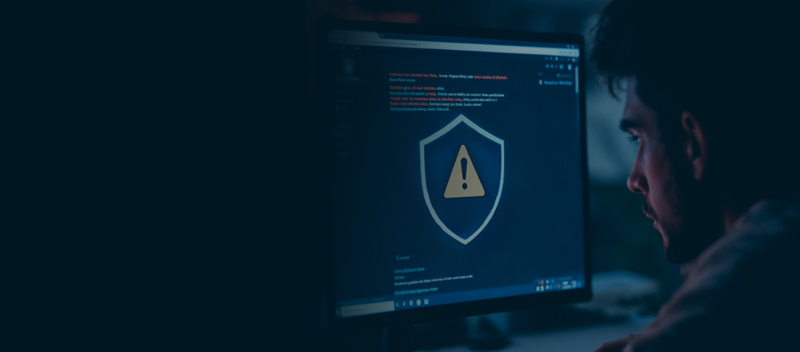Blog Defining Your SOC 2 Scope: A Comprehensive Guide
Defining Your SOC 2 Scope: A Comprehensive Guide

SOC 2, or Systems and Organization Controls 2, is a framework designed to help businesses manage customer data based on the five “trust service principles.” SOC 2 compliance is not just a regulatory requirement but a crucial element in building trust with clients and stakeholders.
One of the fundamental aspects of SOC 2 compliance is defining your SOC 2 scope. This involves determining which systems, processes, and data are covered by the SOC 2 audit. In this comprehensive guide, we will explore the importance of defining a clear and accurate SOC 2 scope. By doing so, you can streamline your audit process, reduce risks, and ultimately achieve lasting compliance success.
Understanding SOC 2 Scope
SOC 2 Compliance adheres to the guidelines for handling client data published by the American Institute of Certified Public Accountants (AICPA). This management is evaluated based on five Trust Services Criteria.
SOC 2 Compliance is built around the five “trust services principles,” namely security, availability, processing integrity, confidentiality, and privacy.
Security. Information and systems are protected against unauthorized access, unauthorized disclosure of information, and damage to systems that could compromise the availability, integrity, confidentiality, and privacy of information or systems and affect the entity’s ability to achieve its objectives.
Security refers to the protection of
- i. information during its collection or creation, use, processing, transmission, and storage, and
- ii. systems that use electronic information to process, transmit or transfer, and store information to enable the entity to meet its objectives. Controls over security prevent or detect the breakdown and circumvention of segregation of duties, system failure, incorrect processing, theft or other unauthorized removal of information or system resources, misuse of software, and improper access to or use of, alteration, destruction, or disclosure of information.
Availability. Information and systems are available for operation and use to meet the entity’s objectives.
Processing Integrity. System processing is complete, valid, accurate, timely, and authorized to meet the entity’s objectives.
Confidentiality. Information designated as confidential is protected to meet the entity’s objectives. Confidentiality addresses the entity’s ability to protect information designated as confidential from its collection or creation through its final disposition and removal from the entity’s control in accordance with management’s objectives.
Privacy. Personal information is collected, used, retained, disclosed, and disposed of to meet the entity’s objectives.
The Impact on the Audit Process and Report
The scope of your SOC 2 audit directly influences the audit process and the resulting report. A well-defined scope ensures:
-
- Comprehensive Coverage: All relevant systems and processes are examined, leaving no critical areas unchecked.
- Focused Audit: Auditors can concentrate on specific areas, making the audit more efficient and effective.
- Risk Mitigation: Identifying and including all relevant areas helps in addressing potential risks proactively.
- Clear Reporting: The final SOC 2 report will provide a detailed assessment of the scoped areas, offering valuable insights into your organization’s compliance status.
By meticulously defining your SOC 2 scope, you not only streamline the audit process but also enhance the robustness of your data security and privacy measures, fostering greater trust with clients and stakeholders.
For more on our SOC 2 compliance services, Click Here
Factors to Consider When Defining SOC 2 Scope
Understanding these factors can help ensure that your scope is both comprehensive and manageable, aligning seamlessly with your organizational goals.
Key Influencing Factors
When determining your SOC 2 scope, consider the following aspects:
-
- Business Operations: Assess which systems and processes are critical to your business operations. This includes IT infrastructure, data processing activities, and service delivery mechanisms.
- Customer Requirements: Many customers have specific compliance expectations. Understanding and incorporating these requirements into your SOC 2 scope can enhance customer trust and satisfaction.
- Regulatory Obligations: Different industries are subject to various regulatory standards. Ensure your SOC 2 scope accounts for all relevant legal and regulatory requirements to avoid non-compliance issues.
Aligning Scope with Organizational Goals
It is crucial that the SOC 2 scope aligns with your broader organizational goals. Consider the following:
-
- Strategic Objectives: Ensure that the systems and processes included in your SOC 2 scope support your long-term business strategy.
- Risk Management: Incorporate key risk areas identified by your organization’s risk management framework to ensure that potential vulnerabilities are addressed.
- Operational Efficiency: A well-aligned SOC 2 scope can help streamline operations, reduce redundancies, and improve overall efficiency.
Balancing Comprehensive Coverage with Manageable Scope
- Striking the right balance between comprehensive coverage and a manageable scope is essential for a successful SOC 2 audit:
- Prioritize Critical Areas: Focus on the most critical systems and processes first, then expand the scope as needed.
- Incremental Approach: Start with a narrower scope and gradually include additional areas in subsequent audits. This phased approach allows for more manageable and focused audits.
- Resource Allocation: Assess your available resources, including time, budget, and personnel. Ensure the scope is realistic given these constraints to avoid overextending your capabilities.
Steps to Define Your SOC 2 Scope
Defining your SOC 2 scope is a critical task that requires careful planning and a thorough understanding of your systems and processes. Below is a step-by-step guide to help you navigate this process effectively.
Step One: Select Relevant Trust Services Criteria (TSC)
The first crucial step in defining your SOC 2 scope is selecting the relevant Trust Services Criteria (TSC) that apply to your specific business operations and industry. Think of this as choosing the key players for your team.
Step Two: Identify Services Included in the Scope
One of the foundational tasks in preparing for a SOC 2 audit is specifying which services will be included in the audit scope. This includes any service that interacts with sensitive data, from collection and storage to processing and transmission. For instance, if your organization provides services such as cloud computing, managed IT services, or data hosting, these must be included in the scope. It’s essential to demonstrate how these services comply with the relevant TSCs.
Step Three: Incorporate Policies, Procedures, Systems, and Personnel
A comprehensive SOC 2 scope must encompass all relevant policies, procedures, systems, and personnel involved in handling sensitive data. Each of these elements plays a critical role in ensuring SOC 2 compliance:
-
- Policies: Ensure that all security practices are governed by well-documented policies. This includes key SOC 2 policies like vendor management and data privacy policies.
- Procedures: Include Standard Operating Procedures (SOPs), which provide step-by-step guidance for specific security tasks. Examples include incident response plans and remediation procedures.
- Systems: Document all technical and physical systems relevant to the chosen trust principles. This encompasses devices, software, and network components used to manage information security risks.
- Personnel: Clearly define the roles and responsibilities of all personnel involved in managing controls. Your employees are your first line of defense, so it’s crucial to include everyone who contributes to data security.
Step Four: Determine Your SOC 2 Report Type
Understanding the type of SOC 2 report needed is vital for aligning your audit strategy:
-
- Type I Report: This report provides a snapshot of the design of controls at a specific point in time. It evaluates whether the controls are suitably designed to meet the trust service criteria.
- Type II Report: Preferred for organizations seeking a higher level of assurance, this report assesses both the design and operating effectiveness of controls over a specified period. It provides a more comprehensive view of how well the controls function in practice.
Role of System Boundaries in Scope Definition
System boundaries are crucial in defining the SOC 2 scope as they delineate the extent of your audit. Clearly defined boundaries help auditors understand the areas under review and ensure that all critical components are included. This clarity is essential for an effective and focused audit process.
Identifying and Documenting System Components
Identifying and documenting system components involve:
- Listing all hardware and software: Include servers, workstations, network devices, and applications.
- Documenting data storage: Identify databases and storage locations for sensitive data.
- Mapping network infrastructure: Detail network configurations, including firewalls, routers, and switches.
Tips for Creating a Clear and Concise Scope Statement
-
- Be Specific: Clearly specify which systems, processes, and data are included.
- Use Simple Language: Avoid technical jargon to ensure the scope statement is understandable by all stakeholders.
- Highlight Key Areas: Emphasize critical components and any exclusions.
- Keep It Concise: Aim for brevity while ensuring all necessary details are covered.
Common SOC 2 Scope Challenges and Solutions
Understanding these common challenges and implementing practical solutions can help ensure a smoother path to SOC 2 compliance.
Common Challenges
— Scope Creep
Challenge: As organizations delve deeper into the SOC 2 preparation, the scope may continue to expand beyond the original plan, leading to increased complexity and resource strain.
Solution: Establish clear, well-defined objectives from the outset and document the scope meticulously. Regularly review and adjust the scope to ensure it remains manageable and aligned with initial goals.
— Resource Limitations
Challenge: Limited resources, including time, budget, and personnel, can hinder the ability to thoroughly define and manage the SOC 2 scope.
Solution: Prioritize critical systems and processes that need to be included in the scope. Allocate resources strategically, ensuring that key areas receive adequate attention without overextending the organization’s capabilities.
— Misalignment with Business Objectives
Challenge: The SOC 2 scope may sometimes be misaligned with the organization’s overarching business objectives, leading to inefficiencies and potential compliance issues.
Solution: Align the SOC 2 scope with the organization’s strategic goals. Engage business leaders in the scope definition process to ensure that compliance efforts support broader business objectives and drive value.
— Inadequate Documentation
Challenge: Poor documentation can lead to misunderstandings and gaps in the SOC 2 scope, making it difficult to achieve and demonstrate compliance.
Solution: Maintain detailed and accurate documentation of all processes, systems, and controls included in the SOC 2 scope. Use standardized templates and tools to ensure consistency and completeness.
Practical Solutions
- Set Clear Objectives: Define the specific goals of the SOC 2 audit early in the process. Clearly articulate the intended outcomes and criteria that will be assessed.
- Prioritize Resources: Focus on the most critical aspects of your operations that need to be included in the SOC 2 scope. Allocate resources efficiently, ensuring that high-risk areas receive the most attention.
- Regular Reviews: Conduct periodic reviews of the SOC 2 scope to ensure it remains relevant and manageable. Adjust the scope as necessary to address any emerging issues or changing business needs.
Importance of Collaboration
Effective collaboration between IT, security, and compliance teams is essential for defining a comprehensive and effective SOC 2 scope. Each team brings unique insights and expertise, contributing to a well-rounded and robust compliance strategy.
- IT Team: Provides technical knowledge of the systems and processes involved, ensuring that all relevant components are included in the scope.
- Security Team: Focuses on identifying and mitigating risks related to data protection, ensuring that security measures are adequately addressed.
- Compliance Team: Ensures that the SOC 2 scope meets regulatory requirements and aligns with industry standards, guiding the organization through the audit process.
By fostering collaboration across these teams, organizations can create a cohesive and effective SOC 2 scope that supports compliance efforts and enhances overall security posture.
Mastering SOC 2 Compliance
Defining a precise SOC 2 scope is crucial for ensuring compliance and safeguarding sensitive data. A well-structured scope paves the way for thorough audits, mitigates risks, and builds trust with clients, ultimately positioning your organization as a secure and reliable entity.
Partnering with TrustNet offers unparalleled expertise in navigating SOC 2 requirements. Our team of seasoned experts ensures your SOC 2 scope is meticulously defined and aligned with your business objectives, facilitating a seamless path to compliance.
Talk to an Expert today.




